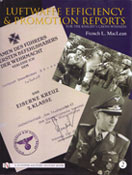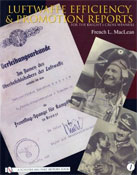
Luftwaffe Efficiency and Promotion Reports for the Knight’s Cross Winners, Volume 2
Walter Matoni, “Mentally, interested and versatile.”
Wilhelm Mayer, “He shows talent for quick comprehension and great mental flexibility.”
Maximilian Mayerl, “He brought back the old enthusiastic spirit of the entire squadron.”
Julius Meimberg, “Very passionate, outstanding fighter pilot.”
Joachim Meissner, “‘Lieutenant Meissner’ will be a valuable addition for the Luftwaffe.”
Hans Hermann Merker, “Well-liked by comrades and superiors.”
Heinz Meyer, “He succeeded in such devastating blows to the Americans at Monte Castre that he was recommended for the Oak Leaves to the Knight’s Cross of the Iron Cross for this outstanding success.”
Werner Milch, “Distinguished himself through extraordinary courage and relentless personal engagement.”
Helmut Missner, “Ability to quickly comprehend.”
Horst Müller, “Sometimes his temperament appears to be boisterous and blustery.”
Karl-Friedrich Müller, “Possesses a lot of youthful élan and can be very enthusiastic.”
Dr. Maximilian Otte, “In difficult situations, he has demonstrated a high degree of courage and decisiveness.”
Karl August Paulsen, “He is an officer who, by reason of his great sense of justice, will always be a good superior.”
Viktor Petermann, “Of particular note are his cold-bloodedness, dare-devil nature and eagerness for action.”
Karl Peters, “Great mental flexibility.”
Herbert Pölz, “Takes remarks of a general nature too personal.”
Dietrich Puttfarken, “Sometimes he is a little too fast in making judgments and remarks.”
Rudolf Rademacher, “Somewhat disinterested and stubborn.”
Hans Roehrig, “Very good athlete.”
Herbert Röwer, “Mentally above average, with diverse interests.”
Erich Rudorffer, “He is an example for the men under his command.”
Martin Schächter, “During an artillery attack on the division command post at the Invasion Front, he was buried alive and again wounded.”
Wolfgang Schellmann, “An exemplary military trainer and educator for his squadron.”
Wolfgang Schenck, “He appears to have lost his spirit for battle and is tired of being at the front.”
Horst Schiller, “Very passionate Stuka pilot of outstanding courage and untiring eagerness for combat.”
Horst Schimpke, “He is diligent, conscientious and eager to work.”
Leonhard Schmidt, “Has always been an exemplary platoon leader and has consistently proved his unusual courage in the heaviest combat.”
Otto Schmidt, “In every respect, well-rooted character.”
Heinz Schnaufer, “Somewhat shy.”
Herbert Schob, “Full of humor.”
Rudolf Schoenert, “He always looks for new missions.”
Walter Schuck, “Slender build, but has endurance and hardiness.”
Wolf-Werner von der Schulenburg, “Despite his age and the severe injuries suffered during the World War – one leg 5 cm shorter than the other – at the beginning of the war, he reported to the parachute troops.”
Franz Schwaiger, “Inspiring and an example in every respect for the young pilots.”
Georg Seelmann, “Straight-forward, intelligent human being.”
Günther Sempert, “Mentally very active, skillful in quick comprehension.”
Friedrich Seyffardt, “Overseeing and mastering every situation with great success.”
Werner Sigel, “Tendency to salesmanship behavior, which manifests itself in his frequent attempts to ‘trade off’ something from clearly spelled out orders.”
Eduard Skrzipek, “Still lacking social manners, particularly in social gatherings.”
Rudolf Smola, “Natural leader.”
Willi Sölter, “Within a very short time, his group has sunk 15,000 tons commercial shipping capacity and one destroyer, and has also damaged an additional 93,000 tons and \two destroyers.”
Waldemar Stadermann, “Secure and calm in every situation.”
Heinrich Sterr, “He has an enthusiastic heart.”
Walter Stimpel, “He always understands how to comprehend the essential.”
Heinz Strünning, “Could be a little more lively sometimes.”
Karl Tannert, “Tannert with a few men of his headquarters and the signal platoon retook the village on his own initiative, averting a danger to the flank of the regiment and the entire division.
Gerhard Thyben, “Due to his young age, still somewhat unbalanced.”
Cord Tietjen, “Skillful trainer.”
Erich Timm, “Dazzling élan.”
Kurt Ubben, “He has understood how to master the most difficult situations.“
Rudolf Weigel, “Slightly conceited.”
Ernst Weismann, “Confronts all things in life without worry.”
Theodor Weissenberger, “Without a doubt, belongs with the best fighter group commanders.”
Walter Werner, “His outstanding courage during the Second Cassino Battle marks the typical resolute soldier in his personality.”
Heinz Wernicke, “Would rather have others tell him what to do than to reach for his own initiative.”
Otto Wessling, “For the men under his command, he is a thoroughly just superior.”
Walter Wolfrum, “Serial victories are not rare for him.”
Otto Würfel, “Physically able to bear a burden.”
Hilmar Zahn, “Understands exceedingly well how to make gunnery training interesting and diversified.”
Eugen-Ludwig Zweigart, “He possesses a clear manner of giving orders.”

